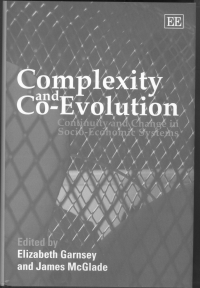Reviewed by
Mauro Lombardi
Department of Economics, University of Firenze
 In this book, the JASSS readers can find thoroughly analysed the very interesting topics which can be explored if the General Linear Model (GLM), which is still prevailing in the social sciences, is finally transcended. Indeed, if basic assumptions of GLM are dropped (such as fixed entities with changing attributes, monotonic causal flows, unequivocal meaning, independence of contexts), we enter a completely new world of meanings, that of complex systems (CS), which is characterised by a series of fundamental new properties, such as non-determinism and non-tractability, limited functional decomposition, distributed nature of information and representation, emergence and self-organization. These concepts are put forth in the first chapter of this very interesting book, where the paramount importance of studying the co-evolutionary dynamics within CS is explained, in relation to increasing diversity or degrees of freedom.
In this book, the JASSS readers can find thoroughly analysed the very interesting topics which can be explored if the General Linear Model (GLM), which is still prevailing in the social sciences, is finally transcended. Indeed, if basic assumptions of GLM are dropped (such as fixed entities with changing attributes, monotonic causal flows, unequivocal meaning, independence of contexts), we enter a completely new world of meanings, that of complex systems (CS), which is characterised by a series of fundamental new properties, such as non-determinism and non-tractability, limited functional decomposition, distributed nature of information and representation, emergence and self-organization. These concepts are put forth in the first chapter of this very interesting book, where the paramount importance of studying the co-evolutionary dynamics within CS is explained, in relation to increasing diversity or degrees of freedom. The mechanisms that drive the evolution of CS, first of all the generation of micro-diversity, are the main topics tackled in the second chapter. The multi-level nature of economic systems and the propulsive role of the diversity (generated at the lower levels) in driving evolutionary dynamics are analysed by means of a computer simulation model, where the global results (emergent properties) of different exploration strategies by firms are treated.
The usefulness of the complexity framework is also verified in analyzing the complex evolution of cities. The third chapter shows how particular morphological patterns emerge in Las Vegas and London, where peculiar micro-processes and factors (i.e. technological innovation) resulted in self-organized dynamics.
The same theoretical framework is also applied in the field of archaeological studies. Chapter 4 highlights the importance of transcending (even in archaeology) the linear model, which views the long-term "simply as the accumulation of a sequence of short-term events". The adoption of a complexity thinking is then proposed, and fundamental concepts are employed, such as self-organization, attractors, distributed systems, emergence and co-evolution. In this way, the new concept of eco-historical regime is proposed, by defining it as an attractor in a multi-dimensional space (physical, biological, social, symbolic, and cognitive). These conceptual constructs are then used in explaining the trajectory of long term change of the Empordà region (Spain) during the first AD centuries. The paramount importance of some general properties, such as resilience, connectivity, and historical path-dependence, is carefully analysed. As a consequence, instead of a simple sequence of phases, we have complex interactions between multiple spheres and entities.
The economy as a complex adaptive system is at the centre of chapter 5, where the restless nature of the modern capitalist economy is analysed. This is done by expanding the role of knowledge, viewed as the propulsive mechanism able to generate perpetual novelty. The generation of information and knowledge is an essential process fostering irreversible and out of equilibrium socio-economic dynamics. Knowledge processes as individual and social purposeful explorations are also nourished by means of communication exchanges, which support the correlation dynamics and coordination. This latter emerges in terms of patterns of social interaction which lead individual vectors of knowledge towards shared grounds. In this way, an open ended and combinatorial process can result in emergent and changing properties, such as social understanding and systemic coordination.
The complexity of the interrelations between micro and macro processes, as well as the fundamental importance of knowledge production, is at the centre of chapter 6, where the readers can find analysed the concept of resilience from a socio-economic perspective. A co-evolutionary model for industrial and societal transformation is proposed and applied to two deeply different empirical experiences (coal mining industries in South Yorkshire and in Germany). The failure of system resilience (in the first) and the success (in the second) further bear out the importance of knowledge processes as long-term strategic thinking and adaptive management strategies.
The importance of complexity and evolutionary framework is also examined in chapter 7, within which the linkages between variety creation, selection and propagation dynamics are treated, by showing how feedback processes unfold in problem solving activity, which is developed in information and communication technology. In the last chapter, the authors summarize the simplifying assumptions suggested in conventional modelling and display essential points and problems for alternative modelling frameworks.
To conclude, in my opinion, the JASSS readers, who I think are mostly interested in finding sound theoretical models and results, should find in this book both several remarkable insights concerning basic statements of evolutionary theorising and concrete results that can be acquired by applying such basic statements in computer simulation models and in various fields of analysis.
Return to Contents
of this issue
© Copyright Journal of Artificial Societies and Social Simulation, 2007